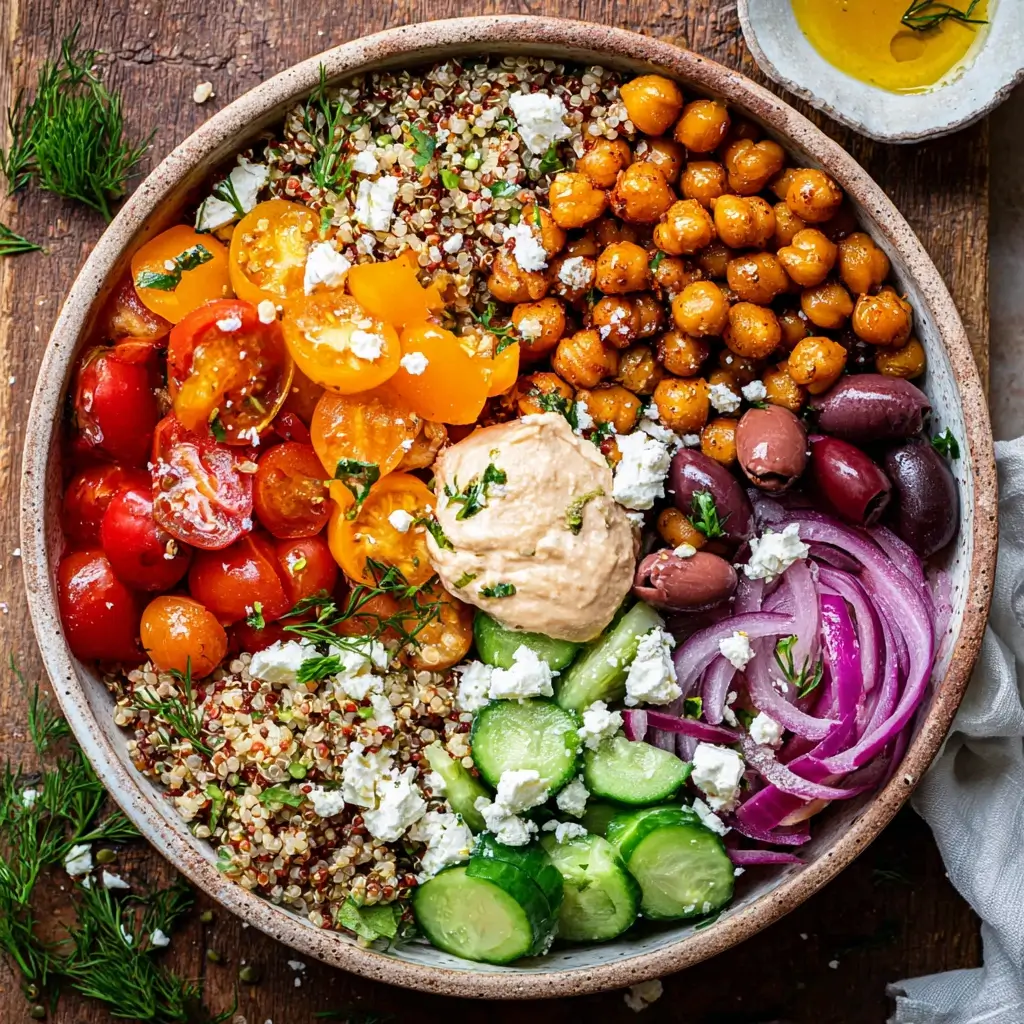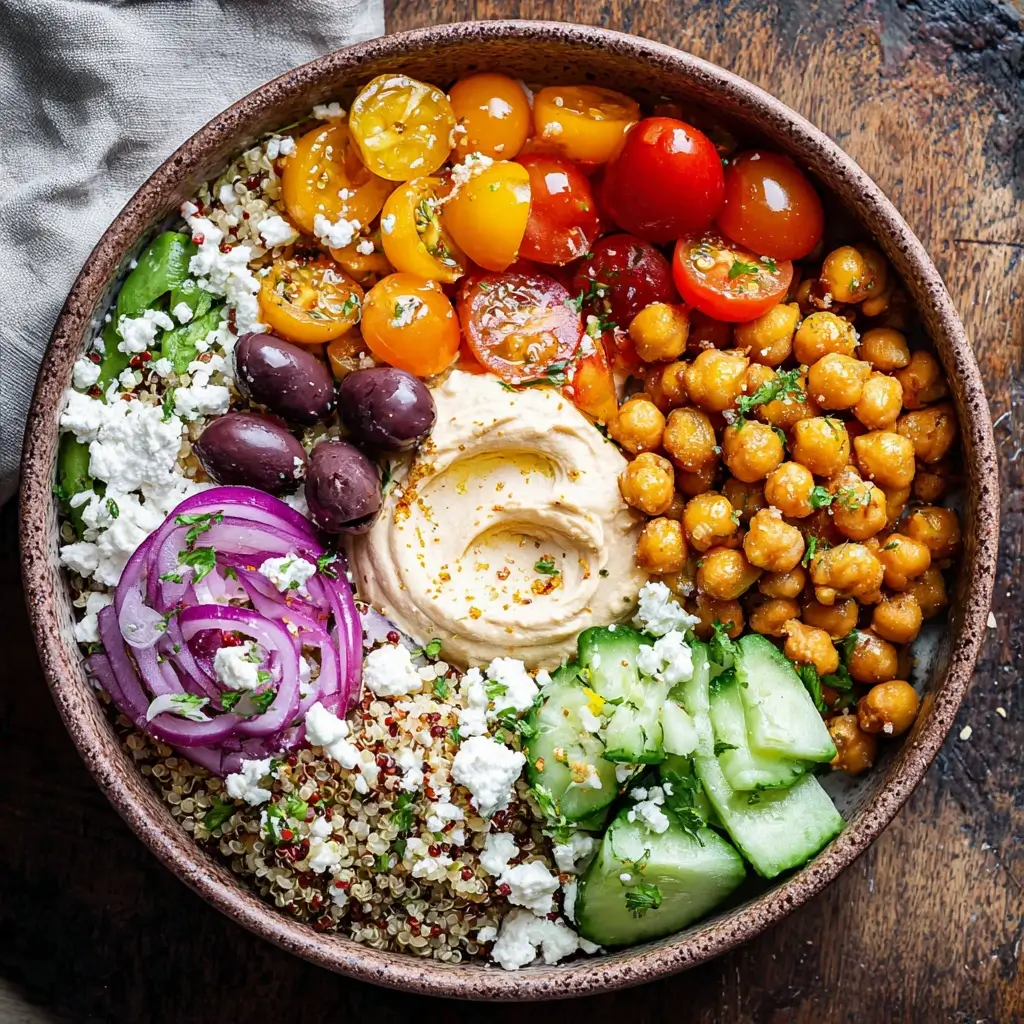Mediterranean Bowl recipes have become my absolute obsession, and for good reason—they’re the perfect antidote to the “what’s for dinner?” panic that hits us all. You know that feeling when you’re staring into the fridge at 6 PM, wondering how to create something both satisfying and healthy? That’s exactly where this vibrant, nourishing bowl comes to the rescue.
Hi, I’m Emeli from FoodFansy, and this Mediterranean Bowl recipe has become my go-to solution for busy weeknights and weekend meal prep alike. After years of exploring kitchens around the world—from bustling street markets in Athens to cozy tavernas overlooking the Aegean Sea—I’ve distilled the essence of Mediterranean eating into this one perfect bowl.
As someone who’s spent countless hours perfecting the balance of flavors, textures, and nutrients, I can promise you this: this Mediterranean Bowl delivers restaurant-quality taste with home-kitchen simplicity. The secret lies in the perfectly spiced roasted chickpeas, fluffy quinoa, and that magical combination of fresh vegetables that transport you straight to the sun-soaked coastlines of the Mediterranean.
In this comprehensive guide, you’ll discover my foolproof techniques for achieving the perfect chickpea crispiness, learn why certain ingredient choices make all the difference, and master the art of bowl assembly that makes every bite a symphony of flavors. Plus, I’ll share my favorite variations and pro tips that will have you creating Mediterranean Bowl masterpieces in your own kitchen.
Why This Mediterranean Bowl Recipe Works
This Mediterranean Bowl recipe isn’t just another healthy meal—it’s a perfectly orchestrated symphony of flavors, textures, and nutrients that actually satisfies. Here’s what makes it so incredibly effective:
Uses affordable, pantry-friendly ingredients that deliver gourmet results. Every component, from the humble chickpeas to the vibrant vegetables, is easily accessible yet transforms into something extraordinary when combined with the right techniques and seasonings.
Ready in just 30 minutes with minimal active cooking time. While the chickpeas roast themselves to golden perfection and the quinoa simmers away, you’re free to prep the fresh components—making this ideal for busy weeknights when time is precious.
Perfect for meal prep warriors and spontaneous dinner solutions alike. The components store beautifully separately and can be assembled fresh throughout the week, or everything can be prepared à la minute when you’re craving something immediately satisfying.
Delivers complete nutrition without sacrificing an ounce of flavor. This bowl provides plant-based protein, healthy fats, complex carbohydrates, and a rainbow of vitamins and minerals—proving that eating well doesn’t mean eating boring.
Choosing the Right Ingredients for Your Mediterranean Bowl
Best Base Components for This Mediterranean Bowl Recipe
The foundation of any exceptional Mediterranean Bowl lies in selecting quality base ingredients that provide both substance and flavor. Quinoa serves as our protein-rich grain base because its nutty flavor and fluffy texture perfectly complement the Mediterranean flavor profile, while chickpeas become the star protein when properly seasoned and roasted to achieve that irresistible crispy exterior with a creamy interior.
For the chickpeas, always opt for canned varieties that are firm and well-drained—this saves time without compromising quality. Look for brands that don’t add excessive sodium, as we’ll be seasoning them ourselves for optimal flavor control.
Buying Tips for Mediterranean Bowl Success
When selecting your vegetables, prioritize freshness and color vibrancy. Cherry tomatoes should be firm with bright, glossy skin—avoid any that feel soft or show signs of wrinkling. Cucumbers should feel heavy for their size with unblemished skin, while bell peppers should have crisp walls and vibrant color without any soft spots.
For the best quinoa results, choose organic, pre-rinsed varieties when possible to eliminate the natural saponin coating that can create bitterness. If your quinoa isn’t pre-rinsed, a thorough cold water rinse until the water runs clear is essential.
Smart Substitutions for Your Mediterranean Bowl
Swap quinoa for bulgur wheat, farro, or brown rice if you prefer different grains—just adjust cooking times accordingly. Each brings its own unique texture and nutritional profile while maintaining the Mediterranean essence.
Replace chickpeas with white beans, lentils, or even grilled halloumi for protein variety. The key is maintaining that satisfying, substantial element that makes this bowl a complete meal rather than just a salad.
Ingredients & Prep for the Perfect Mediterranean Bowl
Essential Mediterranean Bowl Prep Techniques
Proper chickpea preparation is crucial for achieving that coveted crispy texture. After draining and rinsing your canned chickpeas, pat them completely dry with paper towels—any residual moisture will prevent proper crisping. For extra insurance, let them air-dry for 10-15 minutes before seasoning.
The spice blend transforms ordinary chickpeas into flavor powerhouses. Our combination of smoked paprika, garlic powder, oregano, and onion powder creates layers of Mediterranean aromatics that infuse every bite. The key is tossing the chickpeas while they’re still slightly damp from olive oil, ensuring the spices adhere properly.
Quinoa Mastery for Mediterranean Bowl Success
Perfect quinoa requires the proper water-to-grain ratio and timing. Using a 2:1 water-to-quinoa ratio ensures fluffy, separate grains rather than mushy porridge. Bringing the mixture to a full boil before reducing to a gentle simmer, then letting it steam off the heat for 5 minutes after cooking, creates that ideal texture.
Toast your quinoa for extra flavor depth by dry-sautéing it in your saucepan for 2-3 minutes before adding water. This optional step adds a subtle nuttiness that elevates the entire Mediterranean Bowl experience.
Fresh Component Preparation
Vegetable prep technique affects both flavor and presentation. Cut vegetables into uniform, bite-sized pieces that are easy to eat with a fork. Cherry tomatoes should be halved to release their juices, while cucumbers and bell peppers benefit from a small dice that distributes evenly throughout each bite.
Red onion requires special treatment to tame its sharpness. Slice it as thinly as possible, then soak the slices in cold water for 10 minutes before draining and patting dry. This removes the harsh bite while preserving the onion’s crunch and subtle sweetness.

Step-by-Step Cooking Instructions for Mediterranean Bowl
Pre-Cooking Prep for Mediterranean Bowl Excellence
Begin by preheating your oven to 400°F (200°C) and lining a baking sheet with parchment paper. This ensures even heat distribution and prevents the chickpeas from sticking, making cleanup effortless while guaranteeing perfect results.
Drain and thoroughly rinse your chickpeas, then pat them completely dry with paper towels. This crucial step removes excess sodium from the canning liquid and eliminates surface moisture that would inhibit proper crisping during roasting.
Cooking Method for Perfect Mediterranean Bowl Components
In a mixing bowl, combine the dried chickpeas with olive oil and all the seasonings—garlic powder, smoked paprika, onion powder, oregano, salt, and pepper. Toss everything together until the chickpeas are evenly coated, ensuring each one is glistening with oil and spices.
Spread the seasoned chickpeas in a single layer on your prepared baking sheet, making sure they’re not overcrowded. Roast for 20 minutes, stirring halfway through to ensure even browning. They’re done when golden brown and crispy on the outside.
While the chickpeas roast, prepare your quinoa by combining the rinsed grains with water in a medium saucepan. Bring to a boil, then reduce heat to low, cover, and simmer for 15 minutes until the water is completely absorbed.
Doneness Check for Mediterranean Bowl Components
Perfectly roasted chickpeas should be golden brown with a crispy exterior that gives way to a creamy interior. They should make a slight rattling sound when you shake the pan—this indicates they’ve lost enough moisture to achieve the ideal texture.
Quinoa is done when the grains have absorbed all the water and appear fluffy with visible white rings around each grain. If any water remains after 15 minutes, continue cooking in 2-minute intervals until completely absorbed.
Resting and Final Mediterranean Bowl Assembly
Let the roasted chickpeas cool for 5 minutes before serving—this allows them to firm up and reach peak crispiness. Similarly, fluff the quinoa with a fork and let it rest off the heat for 5 minutes to achieve the perfect texture.
During this resting time, prepare all your fresh vegetables and arrange your mise en place for easy assembly. Having everything ready ensures you can build your Mediterranean Bowl while the warm components are at their optimal temperature.
Pro Tips for Perfect Mediterranean Bowl Results
Avoiding Common Mediterranean Bowl Mistakes
Never skip the chickpea drying step, even when you’re in a hurry. Wet chickpeas will steam rather than roast, resulting in a mushy texture that completely undermines the dish’s textural contrast. If you’re short on time, use a clean kitchen towel to pat them dry more efficiently.
Don’t overcrowd your baking sheet when roasting chickpeas. If they’re too close together, they’ll steam each other and won’t achieve that coveted crispy exterior. Use two baking sheets if necessary—the extra pan is worth the perfect results.
Essential Tool Recommendations for Mediterranean Bowl Success
A fine-mesh strainer is invaluable for properly rinsing quinoa and draining chickpeas. This simple tool ensures you remove all the saponins from quinoa and excess liquid from canned chickpeas, both crucial for optimal results.
Invest in a good-quality baking sheet with a heavy bottom to ensure even heat distribution during chickpea roasting. Thin, lightweight pans create hot spots that lead to unevenly cooked chickpeas—some burnt, others undercooked.
Storage & Reheating Your Mediterranean Bowl Components
Store roasted chickpeas in an airtight container at room temperature for up to 3 days to maintain crispiness. If they lose their crunch, a quick 5-minute stint in a 350°F oven will restore their texture perfectly.
Cooked quinoa keeps in the refrigerator for up to 5 days and freezes beautifully for up to 3 months. Cool it completely before storing, and add a splash of water when reheating to restore its fluffy texture.
Flavor Variations for Your Mediterranean Bowl
Spicy Mediterranean Bowl Twist
Transform your bowl into a fiery delight by adding a pinch of cayenne pepper to the chickpea seasoning or incorporating diced jalapeños into your fresh vegetable mix. A drizzle of harissa oil or a dollop of spicy hummus elevates the heat level while maintaining authentic Mediterranean flavors.
For those who love smoky heat, try adding chipotle pepper flakes to your roasted chickpeas during the last 5 minutes of cooking. This creates a complex, smoky spiciness that pairs beautifully with the cool, fresh vegetables.
Protein-Packed Mediterranean Bowl Variations
Double down on protein by adding grilled chicken, lamb, or salmon alongside your roasted chickpeas. Season the protein with similar Mediterranean herbs—oregano, thyme, and garlic—to maintain flavor harmony throughout the bowl.
For plant-based protein variety, substitute the chickpeas with seasoned lentils or add hemp hearts for a nutrition boost. These alternatives provide different textures while maintaining the bowl’s satisfying, complete-meal status.
Global Mediterranean Bowl Fusion
Create a Moroccan-inspired version by adding preserved lemons, dates, and a sprinkle of ras el hanout to your roasted chickpeas. This North African twist brings sweet and savory complexity that’s utterly addictive.
For a Turkish influence, incorporate sumac into your vegetable mix and use za’atar-seasoned chickpeas. Top with Turkish-style white cheese and a drizzle of pomegranate molasses for an authentic Eastern Mediterranean experience.
Mediterranean Bowl Variation Comparison
| Variation | Key Additions | Flavor Profile | Best For |
|---|---|---|---|
| Classic Mediterranean | Traditional herbs, feta, olives | Fresh, herbaceous, salty | Everyday meals, meal prep |
| Spicy Harissa | Harissa paste, jalapeños, cayenne | Heat with depth, smoky | Heat lovers, winter warmth |
| Moroccan-Inspired | Preserved lemons, dates, ras el hanout | Sweet-savory, exotic | Special occasions, guests |
| Turkish-Style | Sumac, za’atar, pomegranate molasses | Tangy, complex, aromatic | Weekend cooking, flavor exploration |
| Protein-Enhanced | Grilled chicken/salmon, hemp hearts | Substantial, athletic | Post-workout, hearty appetites |
Serving Suggestions for Your Mediterranean Bowl
Pair your Mediterranean Bowl with warm pita bread or naan to create a more substantial meal that’s perfect for sharing. The bread provides a delightful contrast to the bowl’s fresh components while allowing diners to scoop up every last delicious bite.
For wine pairings, choose a crisp Sauvignon Blanc or unoaked Chardonnay that won’t compete with the bowl’s vibrant flavors. The wine’s acidity complements the lemon-bright vegetables while its lightness allows the herbs and spices to shine.
Transform your Mediterranean Bowl into an elegant dinner party option by serving the components family-style, allowing guests to build their own bowls. Provide extra garnishes like toasted pine nuts, fresh herbs, and different varieties of olives for customization.
For casual entertaining, serve alongside other Mediterranean-inspired dishes like spanakopita, dolmas, or a simple Greek salad to create a complete mezze-style spread that celebrates the region’s diverse flavors.
FAQs About Mediterranean Bowl
Can I make this Mediterranean Bowl ahead of time? Absolutely! Prepare all components separately and store them in the refrigerator for up to 3 days. Assemble just before serving to maintain the best textures, especially the crispy chickpeas and fresh vegetables.
What’s the best way to reheat leftover Mediterranean Bowl components? Reheat quinoa and chickpeas separately—quinoa in the microwave with a splash of water, and chickpeas in a 350°F oven for 5 minutes to restore crispiness. Add fresh vegetables and cold components after reheating.
Can I freeze prepared Mediterranean Bowl components? Cooked quinoa and roasted chickpeas freeze well for up to 3 months. Fresh vegetables don’t freeze well, so prepare these components fresh when you’re ready to serve.
Is this Mediterranean Bowl recipe gluten-free? Yes! All components in this recipe are naturally gluten-free, making it perfect for those with gluten sensitivities or celiac disease. Just ensure your spices and other packaged ingredients are certified gluten-free if cross-contamination is a concern.
How can I make this Mediterranean Bowl more filling? Add extra protein like grilled chicken, hard-boiled eggs, or additional beans. You can also increase the quinoa portion or add avocado for healthy fats that increase satiety.
Conclusion
This Mediterranean Bowl recipe represents everything I love about cooking—it’s simple enough for a Tuesday night yet special enough to serve to guests, healthy without being restrictive, and absolutely bursting with the kinds of flavors that make you close your eyes and smile with the first bite.
Fire up your oven and give this recipe a try tonight! I promise it will quickly become one of those go-to meals you find yourself craving regularly. The combination of crispy, spiced chickpeas with fresh vegetables and fluffy quinoa creates the kind of satisfying, nourishing meal that makes healthy eating feel like a celebration rather than a chore.
Join the thousands of home cooks who’ve already fallen in love with this Mediterranean Bowl! Share your creations with me on social media using #FoodFansyMediterranean—I love seeing how you make this recipe your own with personal touches and creative variations.
Ready to explore more Mediterranean-inspired recipes? Try my [Lemon Herb Grilled Chicken] or [Classic Greek Village Salad] next for a complete Mediterranean feast that will transport your kitchen to the sun-drenched coastlines of Greece and beyond. Each recipe builds on these same principles of fresh ingredients, bold flavors, and simple techniques that deliver extraordinary results.
If you enjoyed this recipe, be sure to share it with your friends or save it for later!
I’d love to see your unique twist—feel free to post your photos on Pinterest!

